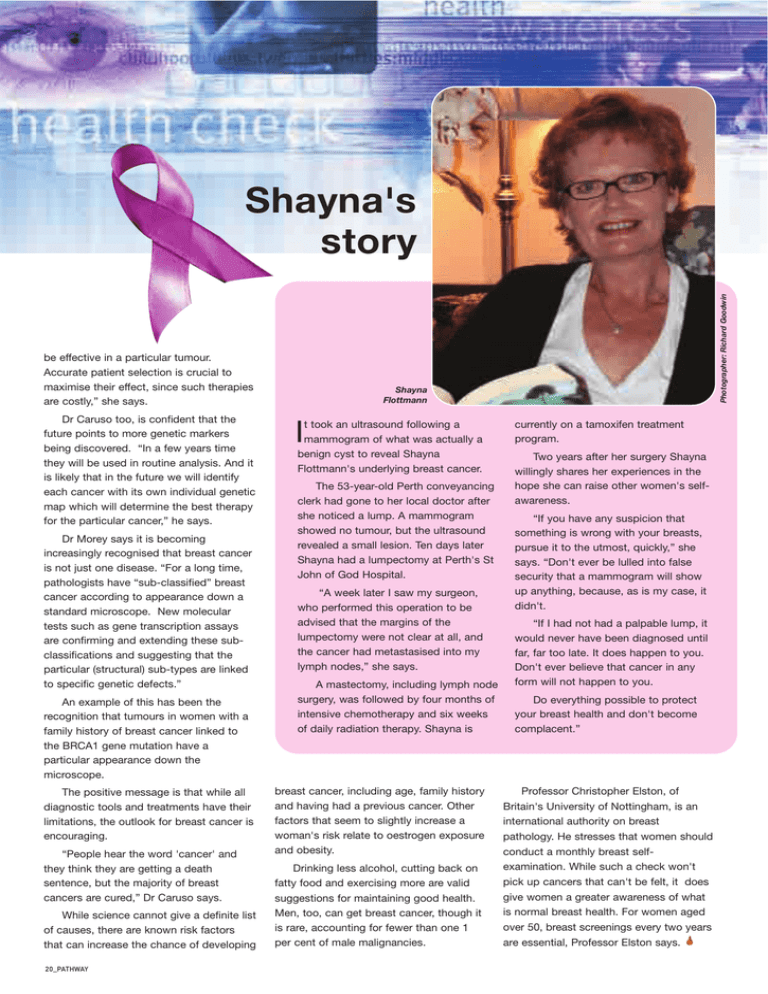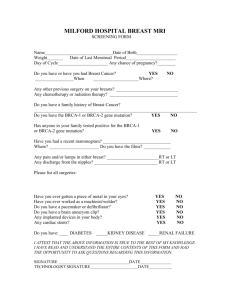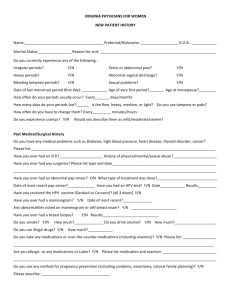be effective in a particular tumour.
advertisement

be effective in a particular tumour. Accurate patient selection is crucial to maximise their effect, since such therapies are costly,” she says. Dr Caruso too, is confident that the future points to more genetic markers being discovered. “In a few years time they will be used in routine analysis. And it is likely that in the future we will identify each cancer with its own individual genetic map which will determine the best therapy for the particular cancer,” he says. Dr Morey says it is becoming increasingly recognised that breast cancer is not just one disease. “For a long time, pathologists have “sub-classified” breast cancer according to appearance down a standard microscope. New molecular tests such as gene transcription assays are confirming and extending these subclassifications and suggesting that the particular (structural) sub-types are linked to specific genetic defects.” An example of this has been the recognition that tumours in women with a family history of breast cancer linked to the BRCA1 gene mutation have a particular appearance down the microscope. The positive message is that while all diagnostic tools and treatments have their limitations, the outlook for breast cancer is encouraging. “People hear the word 'cancer' and they think they are getting a death sentence, but the majority of breast cancers are cured,” Dr Caruso says. While science cannot give a definite list of causes, there are known risk factors that can increase the chance of developing 20_PATHWAY Photographer: Richard Goodwin Shayna's story Shayna Flottmann t took an ultrasound following a mammogram of what was actually a benign cyst to reveal Shayna Flottmann's underlying breast cancer. I The 53-year-old Perth conveyancing clerk had gone to her local doctor after she noticed a lump. A mammogram showed no tumour, but the ultrasound revealed a small lesion. Ten days later Shayna had a lumpectomy at Perth's St John of God Hospital. “A week later I saw my surgeon, who performed this operation to be advised that the margins of the lumpectomy were not clear at all, and the cancer had metastasised into my lymph nodes,” she says. A mastectomy, including lymph node surgery, was followed by four months of intensive chemotherapy and six weeks of daily radiation therapy. Shayna is breast cancer, including age, family history and having had a previous cancer. Other factors that seem to slightly increase a woman's risk relate to oestrogen exposure and obesity. Drinking less alcohol, cutting back on fatty food and exercising more are valid suggestions for maintaining good health. Men, too, can get breast cancer, though it is rare, accounting for fewer than one 1 per cent of male malignancies. currently on a tamoxifen treatment program. Two years after her surgery Shayna willingly shares her experiences in the hope she can raise other women's selfawareness. “If you have any suspicion that something is wrong with your breasts, pursue it to the utmost, quickly,” she says. “Don't ever be lulled into false security that a mammogram will show up anything, because, as is my case, it didn't. “If I had not had a palpable lump, it would never have been diagnosed until far, far too late. It does happen to you. Don't ever believe that cancer in any form will not happen to you. Do everything possible to protect your breast health and don't become complacent.” Professor Christopher Elston, of Britain's University of Nottingham, is an international authority on breast pathology. He stresses that women should conduct a monthly breast selfexamination. While such a check won't pick up cancers that can't be felt, it does give women a greater awareness of what is normal breast health. For women aged over 50, breast screenings every two years are essential, Professor Elston says.





